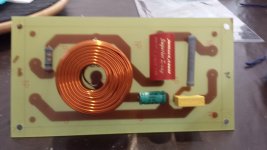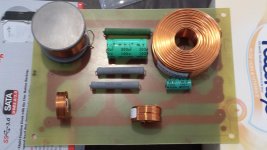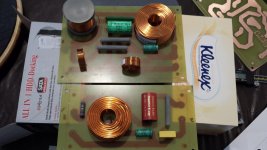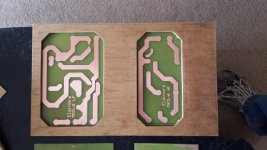When I think of how many phenomena that have been discovered and proven but were misunderstood at first because the reason wasn't clear, this kind of response from others is probably par for the course.
It probably doesn't matter, if you hear it and can fix it then why not?
It probably doesn't matter, if you hear it and can fix it then why not?
When I think of how many phenomena that have been discovered and proven but were misunderstood at first because the reason wasn't clear, this kind of response from others is probably par for the course.
It probably doesn't matter, if you hear it and can fix it then why not?
That was true even about electricity - right from the very beginning.
So yeah, as they say, if it ain't broke, don't fix it. That makes sense.
Then if it works, then don't complain - doesn't that make as much sense?
One of the best stories of all time is about Michael Faraday and James Maxwell. Faraday came from the humblest beginning and yet by sheer persistence he became the eminent experimental scientist of his age. Observing the role of magnets etc, he came to the conclusion that he was observing electromagnetic waves - in the process inventing the first electric motor.
But the establishment was never entirely supportive but gradually Faradays' effort and results became, almost begrudgingly, acknowledged. He rose to a preeminent position.
Then Faraday made a mistake: Without direct proof he expounded the thought that light was also electromagnetic waves... and you can see where this is going. Ridicule was heaped upon him and the establishment finally "got" him.
Then James Maxwell, a much younger man and a mathematical genius, approached Faraday. They became close friends and they realised that they had a similar world view: That God's creation was to be explored with a humble view. These were not "pious" men of the cloth - just a private view they held. Maxwell told Faraday that he believed he was right. At that point C, the speed of light, had been measured and determined and Maxwell realised that if he could devise an equation that equaled C, then he would have proved Faraday right.
The rest is of course history - and in his study Einstein would have the pictures of Newton, Faraday and Maxwell on the wall. Would Einstein have come up with E=MC^2 if it was not for Faraday and Maxwell?
Yes, quite are right - history does repeat itself - and so does human nature, both for good and bad.
Cheers, Joe
.
Last edited:
A bit earlier than the Lipinski loudspeakers:
Artemis Systems Eos Signature loudspeaker & Base Module Measurements | Stereophile.com
Reference (Lipinski):
Lipinski Sound L-707 loudspeaker Measurements | Stereophile.com
Artemis Systems Eos Signature loudspeaker & Base Module Measurements | Stereophile.com
Reference (Lipinski):
Lipinski Sound L-707 loudspeaker Measurements | Stereophile.com
I ordered the last of the components I needed to finish building these this weekend. As I mention in another post I am laminating 3/16 HDF together and I still have 4 sets left I need to glue.
I am going to try to get at least one done tonight. Once I start the rest of the construction I'll post more pics.
I had to order the Jantez Plus caps because Parts Express won't have the other Audyn True Copper in until Sept 15...and they keep pushing back the due in date. (I bought the last 1 they had in stock.)
I hope to have this finished in the next 2-3 weeks...we'll see. Now that i have everything I'll be chomping at the bit.
I am going to try to get at least one done tonight. Once I start the rest of the construction I'll post more pics.
I had to order the Jantez Plus caps because Parts Express won't have the other Audyn True Copper in until Sept 15...and they keep pushing back the due in date. (I bought the last 1 they had in stock.)
I hope to have this finished in the next 2-3 weeks...we'll see. Now that i have everything I'll be chomping at the bit.
A bit earlier than the Lipinski loudspeakers:
Artemis Systems Eos Signature loudspeaker & Base Module Measurements | Stereophile.com
Reference (Lipinski):
Lipinski Sound L-707 loudspeaker Measurements | Stereophile.com
I think I know why you posted above.
Yes, the Lipinski has a design feature that I also use - I know I use it deliberately and I think he does too. The Tweeter's phase in low order networks has to be in the opposite phase because below a specific frequency it inverts the phase - it is pure physics that can't be changed. A guy I know who runs a studio in Athens (the original) alerted me to the fact that B&W speakers have also come to a similar conclusion and they announced they were now reversing the Tweeter because they were getting better integration - so the Eos example is a good one and I like reading Atkinson's stuff because he is a thinker. His remark that Eos says the speaker should only be listened at farfield is also interesting, because in farfield the Tweeter's phase becomes less critical and at infinity (you won't hear anything there) it shouldn't matter at all. But he forgets to add that if you reverse the Tweeter, then it works in both nearfield and farfield - so guess which one I prefer?
Besides, most of us listen not quite nearfield and yet not truly farfield, which in my mind should be 3.5M or more - does anybody here, hands up? Ahh... I thought not.
In that case, only one answer, reverse that Tweeter!
(Mind you, this is different from measurement nearfield and measurement farfield, which one is in centimeters and the other one metre or more respectively.)
Cheers, Joe
I think I know why you posted above.
..only one answer, reverse that Tweeter!
Cheers, Joe
(..It's strange though, I don't even remember why I was looking over the measured characteristics of loudspeakers on Stereophile at that particular time, but when I spotted fig. 11 on the Artemis Systems speaker - I thought: "hmm, Joe might like to see this".)
Had a look at v6 crossover plan and noticed that on the tweeter section there is a resistor and cap in red listed before the c1. Is that an optional addition and if so what changes does it make?
Sent from my SM-G900F using Tapatalk
The Elsinore Mk6 are unusual in the sense that it can be driven by a transconductance amplifier, that is, from a power amplifier that outputs, not volts, but current (sometimes also called current steering). That pre-Zobel is needed to EQ the current from the amplifier and it means that it can be driven by any source impedance. So it is semi-optional, but more compulsory than optional in my mind.
You can build this, not very expensive, but if you are capable, then it sounds really good with Elsinore Mk6:
http://www.diyaudio.com/forums/chip-amps/239321-joe-rasmussen-trans-amp-40-watt-transconductance-current-amplifier.html
Cheers, Joe
Thx Joe, the reason I was asking is I am finding my speakers a bit "bright" or aggressive in the attack as someone else said on listening. I've tried postioning according to your recommendations with toe and of the wall. But still seems to be a bit exaggerated in the top end especially when you stick a bit of volume in it. I took the speakers across to a friends place who has a nice Macintosh amp and still the same issue. The balance is not quite there. I'm wandering if it could be a wiring issue or maybe a problem with the crossover? I was also thinking of trying the bolster 33r mod. Any advice?
Sent from my SM-G900F using Tapatalk
Sent from my SM-G900F using Tapatalk
Hi Guys.
putting up some pics of my xovers. the High and Low Frequency sections are asembled on separate boards so they can be mounted as far apart in the foot of my speakers to minimise interference. components are only assembled in the board at the moment. nothing permanantly fixed as yet.
putting up some pics of my xovers. the High and Low Frequency sections are asembled on separate boards so they can be mounted as far apart in the foot of my speakers to minimise interference. components are only assembled in the board at the moment. nothing permanantly fixed as yet.
Attachments
Thx Joe, the reason I was asking is I am finding my speakers a bit "bright"...
I would definitely check the wiring - the old reference had to do with the Peerless HDS drivers having a bit of a peak at 4KHz, but one that ameliorated when toeing out and listening more off axis. But the MK6 should have no such problem. I am wondering if you got the phases right.
Cheers, Joe
Re the Bolsert, I have not modeled what it would do to EL-6, but it did change the response in the Mk5 and less upper mid and lower treble. Maybe helped in brighter rooms and also the peak near 4KHz were ameliorated, but in that case I suggested listening further off axis. It also dropped the Z below 250Hz to below 5 Ohm. So for various reasons I was less than totally enthusiastic. In the Mk6 the SB driver when summed with the tweeter has a bit of a depression in 3-4KHz and hence does not have the Peerless peak. Some may even say that it looks a bit like a "BBC dip" response and there are those that like that, although I did not exactly aim for it.
Link to interesting diyaudio.com discussion about BBC dip - some say it's a fallacy anyway.
But in reality it comes down to experiment with the amount of toe-in, less toe-in less bright and vice versa, also experiment with the amount of absorption in the room - I love my wall rugs and they really work, mix with various surfaces that also introduces diffusing, like book cases, with books of course. It all makes a difference.
Ok did a little more experimenting tonight with the toe as i already have them set from the wall following Joe's recommendations, also they are currently 3m apart.
For reference I initially had them set up so i could just see the inside of the boxes. First change was to move outwards 20mm and i found it still too bright Step 2 was another 30mm for a total of 50mm and i found it now a bit dull and the focus wasnt very good, it didnt gel together. Step 3 i moved them back in a little for a total of 35mm from the start point.... Well what a change 😃 i really couldnt believe how much difference it makes. It sounds wonderful and have been sitting here for three hours enjoying my speakers.
Joe your absolutely correct about positioning and toe, these speakers are very sensitive to the position. Anyone that builds these really need to be careful where they place these and follow Joes recommendations☺
Sent from my SM-T530 using Tapatalk
Out of curiosity how do check that?I would definitely check the wiring - the old reference had to do with the Peerless HDS drivers having a bit of a peak at 4KHz, but one that ameliorated when toeing out and listening more off axis. But the MK6 should have no such problem. I am wondering if you got the phases right.
Cheers, Joe
Sent from my SM-T530 using Tapatalk
Out of curiosity how do check that?
Sent from my SM-T530 using Tapatalk
With a 1.5V battery. With plus to plus, neg to neg, the driver should move forward. With the Tweeter, the cap will prevent DC passing through, so by-pass cap and you should see Tweeter also go forward slightly. Remember that the Tweeter is electrically out of phase though. Let me know how you go.
so do you mean to bypass the crossover all together?With a 1.5V battery. With plus to plus, neg to neg, the driver should move forward. With the Tweeter, the cap will prevent DC passing through, so by-pass cap and you should see Tweeter also go forward slightly. Remember that the Tweeter is electrically out of phase though. Let me know how you go.
Sent from my SM-G900F using Tapatalk
so do you mean to bypass the crossover all together?
Sent from my SM-G900F using Tapatalk
No need to by-pass the 1st test. That should see all the 6.5" drivers move forward together. The Tweeter is more difficult as the series cap will stop it from moving. So trace from where the amplifier connects and get past the Tweeter's series cap and test there.
You can also just disconnect the crossovers altogether and check that the wiring inside the box checks out with the battery. Did you fit the crossover externally?
So when testing the tweeter i should go positive to negative and negative to positive?No need to by-pass the 1st test. That should see all the 6.5" drivers move forward together. The Tweeter is more difficult as the series cap will stop it from moving. So trace from where the amplifier connects and get past the Tweeter's series cap and test there.
You can also just disconnect the crossovers altogether and check that the wiring inside the box checks out with the battery. Did you fit the crossover externally?
Sent from my SM-T530 using Tapatalk
- Home
- Loudspeakers
- Multi-Way
- The "Elsinore Project" Thread
 it is against the rules to comment on moderation....bin time is in store for violators...this is a voluntary forum, we do not edit posts unless requested, we just delete them if part of it breaks rules....
it is against the rules to comment on moderation....bin time is in store for violators...this is a voluntary forum, we do not edit posts unless requested, we just delete them if part of it breaks rules....


